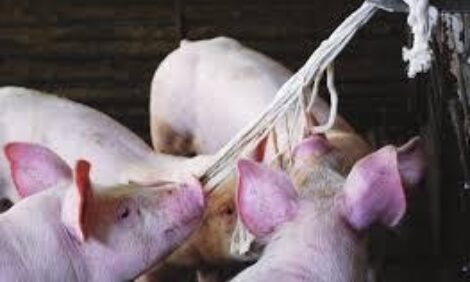



The critical connection: Understanding the impact of feed on swine health
Dr. Francisco Domingues, Anitox Global Technical Director for Swine Markets, speaks about biosecurity for feed and feed ingredientsIt is no secret that feed is central to efficiently rearing healthy, productive swine herds. Continued outbreaks of diseases such as African Swine Fever (ASF), Porcine Epidemic Diarrhea (PEDV), and Porcine Reproductive Respiratory Syndrome (PRRS) and research linking them to feed has inspired many producers to invest in re-evaluating and strengthening their operations biosecurity programs.

“African Swine Fever (ASF) and Porcine Epidemic Diarrhea Virus (PEDv) are major concerns for pork producers worldwide due to their devastating effects on the swine population and significant economic losses. Strengthening biosecurity programs is crucial as there is no one solution to eradicating these viruses and stopping their transmission,” explains Dr. Francisco Domingues, the Anitox Global Technical Director for Swine Markets.
Feed has an extensive history linked to the transmission of pathogens with animal production. According to Dr. Francisco Domingues, feed ingredient bacterial microbial loads can range from less than 100 cfu/g to over 1,000,000 cfu/g, with average microbial loads of 1,000 cfu/g in pelleted diets and 10,000 cfu/g in non-pelleted diets in finished feeds sampled at loadout. Studies have confirmed that feed is not only a fomite for bacterial organisms but also for viral organisms. Swine feed and feed ingredients have been linked to Foot and Mouth Disease, Classical Swine Fever outbreaks, and ASFV, PRRS, SVA, and PEDV survival in feed and feed ingredients, with some further demonstrating that feed acts as an infectious fomite for PEDV and PRRSV, leading to the detection of virus particles and incidence of clinical disease in herds fed contaminated feed.
PEDv significantly reduces the reproductive efficiency of sows, increases mortality rates for piglets and produces fewer piglets weaned per year. This leads to higher piglet costs on the sow farm. A single PEDv outbreak can result in a full month of piglet losses, and it takes about 14 weeks to stabilize the farm once the disease has been eliminated. PEDv also decreases performance by increasing pig mortality and worsening ADG and FCR. ASF is more severe, requiring total depopulation of affected farms, resulting in massive losses. Both viruses incur additional costs due to extra downtime and cleaning.
“It is clear that effective strategies and tools designed to safeguard swine health and productivity are essential to supporting producers. However, another aspect requiring consideration is ensuring that we place effective control and prevention mechanisms at the most impactful points. One of which to consider is feed and feed ingredients," said Dr. Domingues. "Feed is typically produced centrally and, in many cases, includes raw materials imported from regions with a known viral challenge, and then distributed across states, counties and farming operations. Several peer-reviewed studies have highlighted how ingredients such as soybean meal can enhance the survival of some viruses, one specifically evidencing that the half-life of ASFV in feed ranges from 9.6 to 14.2 days, meaning that the total viable virus concentration in feed only decays by half its original level in two weeks. As a result it is crucial to be able to monitor feed quickly and accurately for quantifiable viral contamination to develop realistic and effective hold strategies, which could be further supported by use of effective feed pathogen control tools.”
How do feed pathogen control solutions support swine production?
Feed is one of the few constants within swine production that has a direct line to the gut. Therefore, feed safety is critical to protect animal health, welfare, productivity, and global food safety and security therefore making it a crucial part of a comprehensive swine biosecurity program.
Considerable efforts have been made, but more work remains regarding developing reliable and standardized monitoring protocols for feed mills, especially concerning minimum infectious doses and the efficacy of current virus deactivation methods at the mill level. When looking to feed pathogen control to further strengthen biosecurity and surveillance in the entire system, it is necessary to exercise control over ingredients/raw materials arriving at feed mills, the biosecurity of feed mills, transportation and farm-level biosecurity.
“Feed mills must prioritize biosecurity measures to ensure the safety of animal feed. While heat treatment is commonly used to control feed-source pathogens, in some cases it may not be sufficient to inactivate certain viruses like ASFv. Furthermore, heat treatment does not provide continued protection during transportation and storage, leaving feed vulnerable to recontamination.,” explains Dr. Domingues.
“Crucial elements of a comprehensive biosecurity program include bioexclusion, biocontainment and management to prevent disease introduction, minimize spread and maintain overall herd health. Consistent application of biosecurity initiatives is critical to their efficacy and are best supported with clear standard operating procedures and working instructions,” says Dr. Domingues.
Effective feed-source pathogen control can be achieved by mitigating contamination risks, sourcing high-quality feed ingredients from disease-free areas, protecting ingredients and feed rations from contamination during transport and storage, and ensuring mill hygiene. However, only true feed sanitizers, such as Termin-8® and Finio®, can reduce feed microbial loads and provide continued protection against recontamination until the point of consumption.
Applying feed sanitizers at low inclusion rates can ensure that clean feed moves throughout the feed production system and remains pathogen-free until consumption. This strengthens biosecurity, improves animal performance, and protects the entire food chain. Therefore, feed sanitation is a critical component of swine production that can help safeguard swine health and productivity.
To learn more about feed sanitation can support your operation, visit www.anitox.com.






